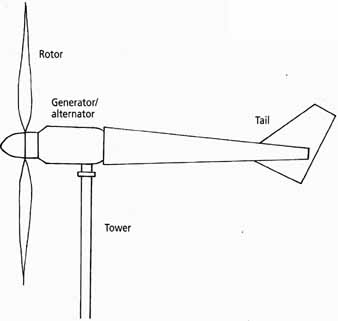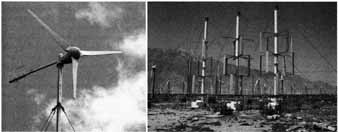Wind generators go by several names: wind turbines, wind machines, and wind plants. All residential wind generators large and small have the same three basic components: (1) a blade assembly, commonly referred to as a rotor, that turns in the wind; (2) a shaft that connects to the rotor and rotates when the blades turn; and (3) a generator, a device that produces electricity ( see ___ below).
Wind machines exist in two basic varieties: horizontal axis units and vertical axis units, as shown in second ___ below. Horizontal axis units are the most widely used in household- sized wind turbines. Vertical axis wind machines, now making a slow comeback, have blades that resemble a big egg beater. When wind strikes the blades, they turn around a vertical shaft.

Anatomy of a wind machine.

Two types of wind machine are in use today: the horizontal
axis machine shown on the left, and the much less common vertical axis
machine on the right.
Because horizontal-axis wind machines are the main players in home wind energy systems, we’ll focus our attention on them. From this point on, when I use the term wind machine, I’ll be referring to horizontal-axis machines. The machines we’ll be studying are typically used to provide back-up power or to supply enough electrical energy to power an entire home, small business, or farm.
A horizontal-axis wind machine is equipped with two or three blades, three being the most widely used and most desirable: the use of three blades results in less wear and tear on the generator in shifting winds and results in more reliable wind turbines. Blades are typically made of a highly durable plastic, fiberglass, or wood with a urethane coating and polyurethane tape to protect the leading edge of the blade from wear.
The blades of a wind machine and the central hub to which they are attached are called the rotor. This is the ‘ of the wind machine.
The rotors of wind machines capture kinetic energy from the wind and convert it into rotating mechanical energy notably a spin- fling shaft, The spinning shaft is attached to the generator. It converts mechanical energy into electrical energy.
Several types of generators are found in household-sized wind machines, The most common is the permanent magnet alternator. When the shaft of a wind machine with a permanent alternator spins, it causes a component called the armature inside the generator to spin. The armature consists of a mass of tightly coiled copper wire. It spins inside a magnetic field. If you remember your high school physics, moving an electrical coil through a magnetic field creates an electrical current in the wires,
DC current produced by a wind generator is carried away by electrical wires. They deliver the electricity to a device known as an inverter. Inverters convert DC current to AC current. They also boost the voltage from 12, 24, or 48 volts, typically produced by wind generators, to 120 volts, the required voltage for most house hold appliances and electronic devices, (You can read more about inverters in Section 7.)
AC Wind Machines? DC electricity is generated by many household wind machines. But DC electricity doesn’t travel well. Voltage drops quickly over distance, rendering a source ineffective. Unfortunately, the electricity generated by wind machines mounted on tall towers must travel long distances to reach battery banks. To avoid line loss, installers use costly, large diameter (low gauge) electrical cable. Several manufacturers also produce wind machines that generate 120-volt or 240-volt AC electricity. The higher voltage AC current they produce is able to travel over great distances without losing power. AC power can be used to power household appliances, but excess AC electricity can be diverted to the grid. Excess can also be stored in batteries. However, to be stored in batteries, AC electricity must first be converted to DC power. This is achieved by installing a bank of diodes in the system. |
Next: Wind Systems: Three Basic Options